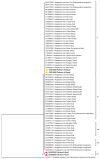Molecular Epidemiology, Seasonality and Phylogenetic Investigations of Anaplasma ovis in Small Ruminants from Diverse Agro-Climatic Regions of Punjab, Pakistan
- PMID: 37894088
- PMCID: PMC10608874
- DOI: 10.3390/microorganisms11102430
Molecular Epidemiology, Seasonality and Phylogenetic Investigations of Anaplasma ovis in Small Ruminants from Diverse Agro-Climatic Regions of Punjab, Pakistan
Abstract
Anaplasma (A.) ovis is the most important cause of anaplasmosis in small ruminants. The current study was planned to estimate the molecular prevalence, risk factors, and phylogenetic analysis of A. ovis infection in sheep and goats from different agro-climatic regions of Central and Southern Punjab, Pakistan. A total of 400 jugular blood samples were collected from asymptomatic goats (n = 200) and sheep (n = 200) from the Jhang and Dera Ghazi Khan districts from January 2021 to February, 2023. Two hundred blood samples were collected from each district. Ten union councils (UC) were randomly chosen from each district, and 20 samples were collected from each UC based on the multistage cluster sampling technique. The samples were analyzed with PCR targeting the major surface protein (msp4) gene of A. ovis. The overall molecular prevalence of anaplasmosis was 57.5%. The disease occurrence was higher in Dera Ghazi Khan (61.5%) than in the Jhang district (53.5%). Infection positivity was greater in goats (65.5%) than in sheep (49.5%). Multivariate logistic regression analysis indicated that host species [sheep; Odds Ratio (OR) = 3.212; p = 0.000, Confidence Interval (CI) = 1.968-5.242], age (adult; OR = 2.606; p = 0.003, CI = 1.398-4.858), and acaricide use (never; OR = 13.671; p = 0.000, CI = 6.414-26.283) were significantly higher risk for A. ovis in small ruminants (p< 0.05; OR > 1). The sequencing and phylogenetic analysis of four representative isolates in the current study (Genbank numbers; Goats: OQ302202, OQ302203; Sheep: OQ319592, OQ319593) revealed novel strains of A. ovis with 97-100% similarity from different countries. The msp4-based goat isolates showed greater genetic diversity, while sheep genotypes showed homology with isolates from Italy, Spain, Hungary, Cyprus, Spain, Iran, and China. The current surveillance study will help in devising prevention and control strategies regarding anaplasmosis in small ruminants. However, there is a need for further study on the clinicopathological and vector competence aspects of these genotypes.
Keywords: Anaplasma ovis; Pakistan; goats; phylogeny; sheep.
Conflict of interest statement
The authors declare no conflict of interest.
Figures



Similar articles
-
Molecular surveillance based on anaplasmosis in domestic small ruminants: First report on zoonotic Anaplasma capra and phylogenetic insights from Faisalabad, Pakistan.PLoS One. 2024 Sep 6;19(9):e0305412. doi: 10.1371/journal.pone.0305412. eCollection 2024. PLoS One. 2024. PMID: 39241048 Free PMC article.
-
Epidemiology and Phylogeny of Anaplasma ovis with a Note on Hematological and Biochemical Changes in Asymptomatic Goats Enrolled from Four Districts in Punjab, Pakistan.Vector Borne Zoonotic Dis. 2023 Oct;23(10):495-506. doi: 10.1089/vbz.2023.0017. Epub 2023 Aug 1. Vector Borne Zoonotic Dis. 2023. PMID: 37527189
-
Molecular epidemiology and phylogeny of Anaplasma species in goats from Pakistan.PLoS One. 2025 May 30;20(5):e0325467. doi: 10.1371/journal.pone.0325467. eCollection 2025. PLoS One. 2025. PMID: 40445980 Free PMC article.
-
Molecular prevalence and phylogeny of Anaplasma marginale, Anaplasma ovis and Theileria ovis in goats and sheep enrolled from a hill station in Punjab, Pakistan.PLoS One. 2023 Nov 8;18(11):e0291302. doi: 10.1371/journal.pone.0291302. eCollection 2023. PLoS One. 2023. PMID: 37939034 Free PMC article.
-
Molecular prevalence and associated risk factors of Anaplasma ovis in Pakistani sheep.Front Vet Sci. 2023 Mar 29;10:1096418. doi: 10.3389/fvets.2023.1096418. eCollection 2023. Front Vet Sci. 2023. PMID: 37065244 Free PMC article.
Cited by
-
Molecular epidemiology and phylogenetic insights of lumpy skin disease in cattle from diverse agro-ecological regions of Punjab, Pakistan.PLoS One. 2025 Jan 13;20(1):e0315532. doi: 10.1371/journal.pone.0315532. eCollection 2025. PLoS One. 2025. PMID: 39804958 Free PMC article.
-
Molecular surveillance based on anaplasmosis in domestic small ruminants: First report on zoonotic Anaplasma capra and phylogenetic insights from Faisalabad, Pakistan.PLoS One. 2024 Sep 6;19(9):e0305412. doi: 10.1371/journal.pone.0305412. eCollection 2024. PLoS One. 2024. PMID: 39241048 Free PMC article.
-
Molecular Prevalence and Phylogenetic Analysis of Anaplasma spp. in Goats from Adana, Türkiye.Vet Sci. 2025 May 15;12(5):481. doi: 10.3390/vetsci12050481. Vet Sci. 2025. PMID: 40431574 Free PMC article.
-
Molecular epidemiology and genetic diversity of Anaplasma and Theileria spp. in Pakistani sheep.PLoS One. 2025 Jul 23;20(7):e0328364. doi: 10.1371/journal.pone.0328364. eCollection 2025. PLoS One. 2025. PMID: 40700395 Free PMC article.
References
-
- Economic Survey of Pakistan . Agriculture, Ministry of National Food Security and Research. Government of Pakistan; Islamabad, Pakistan: 2023. pp. 34–36.
-
- Khan M., Khan M., Ahmad S., Mahmood S. Genetic resources and diversity in Pakistani sheep. Int. J. Agric. Biol. 2007;9:941–944.
Grants and funding
LinkOut - more resources
Full Text Sources

